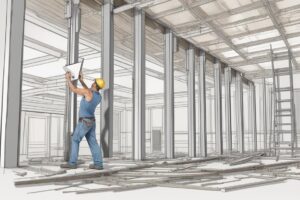
Balancing Beauty and Safety: Deck and Patio Engineering in SF
In the vibrant city of San Francisco, where the picturesque landscapes and pleasant climate beckon outdoor living, the concept of decks and patios takes on a whole new significance. These versatile outdoor spaces not only elevate the aesthetic appeal of residential properties but also provide a tranquil retreat for relaxation and social gatherings.
As much as they enhance the charm of our homes, the safety considerations associated with decks and patios are equally critical. From understanding the benefits and potential hazards to navigating the construction regulations and material choices, there is a myriad of factors to contemplate when it comes to creating a safe and beautiful outdoor space.
In this comprehensive guide, we will explore the intricacies of deck and patio engineering in San Francisco, delving into the benefits, safety concerns, regulations, construction requirements, maintenance, and the invaluable role of professional engineers in ensuring the structural integrity and safety of these outdoor extensions. So, whether you are planning to construct a new deck or patio or seeking to enhance the safety of your existing outdoor space, join us in unraveling the essential insights that will help you strike the perfect balance between beauty and safety.
What Are Decks and Patios?
Decks and patios are outdoor living spaces that provide a seamless integration of architectural and landscaping elements, enhancing the aesthetics and functionality of residential structures.
They offer a versatile platform for creating an inviting outdoor area, allowing homeowners to relax, entertain, and enjoy the natural surroundings. Deck designs can range from traditional wooden structures to modern composite materials, catering to various style preferences and functional needs.
Patios, on the other hand, are often constructed with durable materials like stone or concrete, adding a touch of elegance to the outdoor space. Both decks and patios serve as extensions of the indoor living area, promoting a harmonious connection between the interior and exterior of a home.
What Are the Benefits of Having a Deck or Patio?
Having a deck or patio offers a multitude of benefits, including the expansion of outdoor living spaces, enhancement of architectural aesthetics, and the provision of functional areas for various activities.
What Are the Safety Concerns of Decks and Patios?
The safety concerns related to decks and patios encompass factors such as compliance with building codes, adherence to safety standards, and considerations for weather resistance and structural integrity.
What Are the Common Causes of Deck and Patio Accidents?
Common causes of deck and patio accidents can include structural degradation, inadequate maintenance, and non-compliance with safety measures and regulations.
These factors can contribute to the weakening of the structural integrity of the deck or patio, making them more susceptible to collapses or failures. Improper maintenance such as not repairing or replacing rotten or damaged wood, loose railings, or corroded fasteners can pose serious hazards. Non-compliance with safety standards related to load-bearing capacity, railing heights, and proper installation of hardware can also increase the risk of accidents.
It is crucial for homeowners to prioritize regular inspections, maintenance, and adherence to safety regulations to prevent potential accidents and ensure the longevity of their outdoor structures.”
What Are the Building Codes and Regulations for Decks and Patios in San Francisco?
In San Francisco, the building codes and regulations for decks and patios are governed by stringent standards that emphasize safety compliance, structural integrity, and environmental factors unique to the SF Bay Area.
What Are the Requirements for Deck and Patio Construction?
The requirements for deck and patio construction involve obtaining necessary permits, adhering to construction codes, and ensuring the structural durability and safety of the outdoor structures.
Before starting construction, one must secure the required permits from the local authorities. Adherence to construction codes plays a critical role in ensuring that the deck or patio meets the safety and structural standards prescribed.
It is essential to consider the type of materials, foundation, and weight-bearing factors to enhance the longevity and safety of the structure. Regular maintenance and periodic inspections further contribute to the structural durability and safety of the deck or patio.
What Are the Safety Inspections Required for Decks and Patios?
Safety inspections for decks and patios are essential to ensure compliance with safety regulations, assess structural integrity, and identify any potential safety hazards that require remediation.
These inspections play a crucial role in upholding safety standards and preventing accidents or injuries. By thoroughly evaluating the structural soundness of decks and patios, these inspections help in identifying any weaknesses or signs of deterioration that could pose a risk. Addressing these issues promptly through remediation not only ensures the safety of occupants and visitors but also extends the lifespan of the structure.
Regular safety inspections also provide homeowners with peace of mind, knowing that their outdoor spaces are safe and compliant with regulations.
What Are the Permits Needed for Building a Deck or Patio?
The permits required for building a deck or patio encompass approvals for construction, compliance with local regulations, and adherence to safety standards mandated by the permitting process.
These permits ensure that the construction of decks and patios meets the safety and building regulations set by the local authorities. It is crucial to obtain the necessary permits before commencing the project to avoid legal complications and ensure that the structure is safe and compliant with the relevant codes.
The approval process typically involves submitting detailed plans and specifications for the proposed deck or patio, which are then reviewed to verify compliance with zoning laws, structural requirements, and safety standards.
How Can You Ensure the Safety of Your Deck or Patio?
Ensuring the safety of your deck or patio involves regular maintenance, assessment of structural integrity, and adherence to safety measures to uphold their functional and aesthetic appeal.
What Are the Key Factors to Consider in Deck and Patio Design?
Key factors to consider in deck and patio design include:
- Architectural integration, which is crucial for ensuring that the design of the deck or patio complements the existing structure of the home.
- Landscaping synergy, which involves seamlessly blending the outdoor living space with the surrounding natural environment.
- The balance between aesthetics and functionality, which involves selecting materials and furniture that not only enhance the visual appeal of the space, but also cater to the practical needs of outdoor activities and relaxation.
These considerations are pivotal in creating inviting and cohesive outdoor living areas that seamlessly integrate with the overall design of the property.
How Can You Maintain the Structural Integrity of Your Deck or Patio?
Maintaining the structural integrity of your deck or patio involves regular inspections, proper maintenance of materials, and proactive measures to ensure their long-term durability and safety.
This can be achieved by conducting thorough inspections for any signs of wear and tear, including checking for loose or deteriorating boards, rusting fasteners, and proper drainage. Regularly cleaning and sealing the materials can also prevent moisture damage and decay.
Integrating structural reinforcements, such as using steel connectors or braces, and opting for high-quality, durable materials during construction can significantly enhance their resilience against weather elements and heavy usage.
What Are the Signs of Potential Safety Issues in Decks and Patios?
Recognizing signs of potential safety issues in decks and patios involves identifying structural weaknesses, assessing material degradation, and conducting comprehensive safety inspections to preempt any hazards.
This proactive approach can help safeguard against accidents and mitigate the risk of structural failures. Structural weaknesses may manifest in various forms, such as sagging or uneven boards, corroded fasteners, or cracked support posts. Material degradation, including rot, decay, or rust, can compromise the integrity of the entire structure.
Regular safety inspections, ideally performed by a qualified professional, can identify these potential hazards early and facilitate necessary repairs or replacements, ensuring the continued safety and enjoyment of outdoor spaces.
What Are the Best Materials for Building a Safe and Beautiful Deck or Patio?
Selecting the best materials for building a safe and beautiful deck or patio involves considerations for weather resistance, structural durability, and aesthetic appeal to achieve a harmonious blend of functionality and visual allure.
What Are the Benefits of Hiring a Professional Deck and Patio Engineer in San Francisco?
Engaging a professional deck and patio engineer in San Francisco offers the assurance of expert guidance, adherence to safety standards, and the application of engineering principles to ensure the structural integrity and aesthetic balance of outdoor living spaces.




No Comments